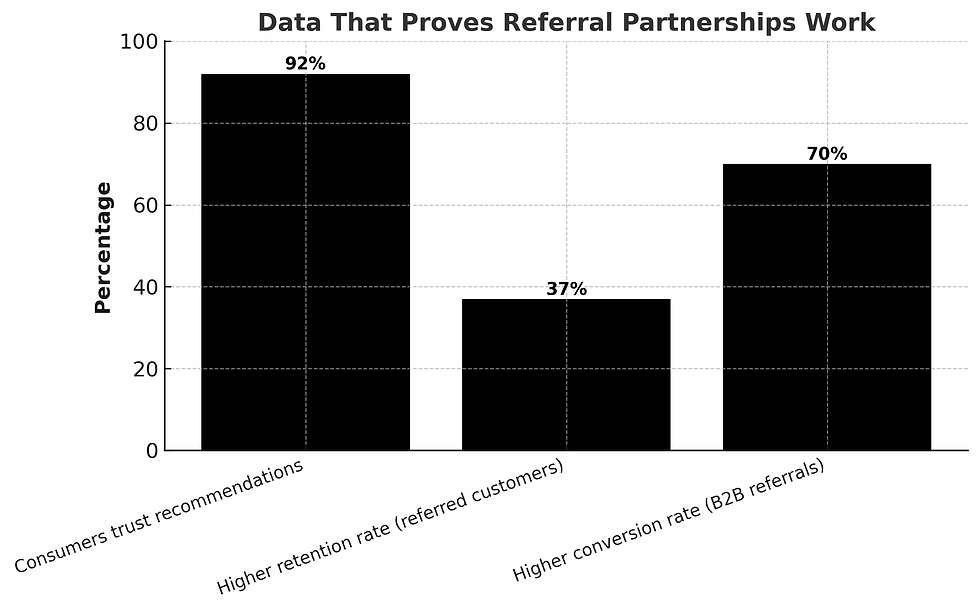The Ultimate Guide to Referral Partnerships for Businesses in 2025
- sushmitakhattriope
- Aug 11
- 3 min read
In today’s competitive business environment, acquiring new customers at a low cost while maintaining high-quality leads is a top priority for companies of all sizes. One of the most effective strategies to achieve this is through referral partnerships.
Referral partnerships leverage trusted relationships between businesses, individuals, or organizations to generate qualified leads and new customers. Unlike cold outreach or traditional advertising, referrals come with a built-in level of trust—making them easier to convert.

In 2025, referral partnerships are becoming increasingly sophisticated, powered by digital tools, data tracking, and strategic collaboration. This guide explores everything businesses need to know about creating and optimizing referral partnerships.
What is a Referral Partnership?
A referral partnership is a business arrangement where one party (an individual, company, or organization) introduces qualified leads to another business in exchange for a reward — usually monetary compensation, discounts, service credits, or reciprocal referrals.
While this sounds similar to affiliate programs, referral partnerships differ in one major way: the emphasis is on personal or professional trust rather than broad online promotion.
Example: If a real estate agent refers clients to a mortgage broker, that’s a referral partnership. It’s not about creating public marketing campaigns — it’s about personal recommendations.
Why Referral Partnerships Are Crucial in 2025
1. Higher Trust, Higher Conversion- Research shows that referred customers have a 16% higher lifetime value and are 4 times more likely to buy compared to non-referred customers.
2. Cost-Effective Customer Acquisition- Unlike ads, which can cost hundreds per lead, referral programs often have zero upfront costs. You only pay after you gain a paying customer.
3. Technology-Driven Tracking- Referral software like PartnerStack, ReferralCandy, and Referral Rock make it easy to automate tracking, payouts, and performance analytics, even for high-volume B2B partnerships.
4. Works Across Industries- From SaaS companies to local service providers, referral partnerships adapt easily to any business model.
Key Components of a Successful Referral Partnership Program
1. Clear Value Exchange- Both parties should benefit. For example, the referrer might receive a fixed commission (e.g., $200 per converted lead) or reciprocal client introductions.
2. Defined Ideal Customer Profile (ICP)- The more specific your ICP, the easier it is for partners to identify and send the right leads.
3. Transparent Rules & Payouts- Have clear terms for what counts as a “qualified referral,” when payouts happen, and how tracking works.
4. Ongoing Partner Enablement- Provide partners with sales materials, pitch scripts, and product updates so they can refer effectively.
5. Relationship Building- Referral partnerships are not “set-and-forget.” Regular check-ins keep partners motivated and aligned.
Real-World Examples of Companies Using Referral Partnerships
Dropbox – One of the most famous examples, Dropbox grew its user base by 3,900% in 15 months with a referral program that rewarded both the referrer and the new user with extra storage.
Tesla – Uses a referral program to encourage existing customers to refer friends. Rewards have included free Supercharging miles, exclusive merchandise, and even invitations to product launches.
HubSpot – Offers a partner referral program for agencies and consultants, giving them commissions for introducing new HubSpot customers.
Airbnb – Leveraged referrals to encourage travelers and hosts to join, offering travel credits to both sides.
Salesforce – Runs a B2B referral program rewarding existing clients and partners for introducing new business customers.
Steps to Launch Your Referral Partnership Program in 2025
1. Identify Ideal Partners- Look for businesses or professionals who share your target audience but aren’t direct competitors.
2. Set Clear Incentives- Monetary rewards, discounts, or mutual referrals all work — choose what’s most appealing to your partners.
3. Use Technology to Track & Scale- Referral software can handle sign-ups, tracking, payouts, and reporting so your program runs smoothly.
4. Train Your Partners- Give them the tools and knowledge to confidently refer you.
5. Measure, Optimize, Repeat- Track conversion rates, reward costs, and lifetime customer value to continuously improve the program.
Data That Proves Referral Partnerships Work
92% of consumers trust recommendations from people they know more than any other form of advertising.
Referred customers have a 37% higher retention rate than non-referred ones.
B2B companies see a 70% higher conversion rate from referrals compared to leads from other source.

Key Takeaways
Referral partnerships are a high-trust, low-cost growth strategy perfect for both B2B and B2C.
Modern referral software makes it easier than ever to scale and manage these programs.
Real-world examples from companies like Tesla, Dropbox, and Salesforce prove their effectiveness.
The best programs focus on relationship-building, clear incentives, and measurable results.
How Openfor.co Can Help
At Openfor.co, we help businesses design, launch, and scale effective referral partnership programs tailored to their industry. Whether you’re a SaaS startup, an e-commerce brand, or a service provider, our platform connects you with the right partners and provides the tools to track and grow your program.
🔗 Explore the Collab Marketplace- https://www.openfor.co/collab-marketplace-all
If you’re ready to turn trusted recommendations into a predictable growth engine, let’s build your referral partnership program together.




Comments